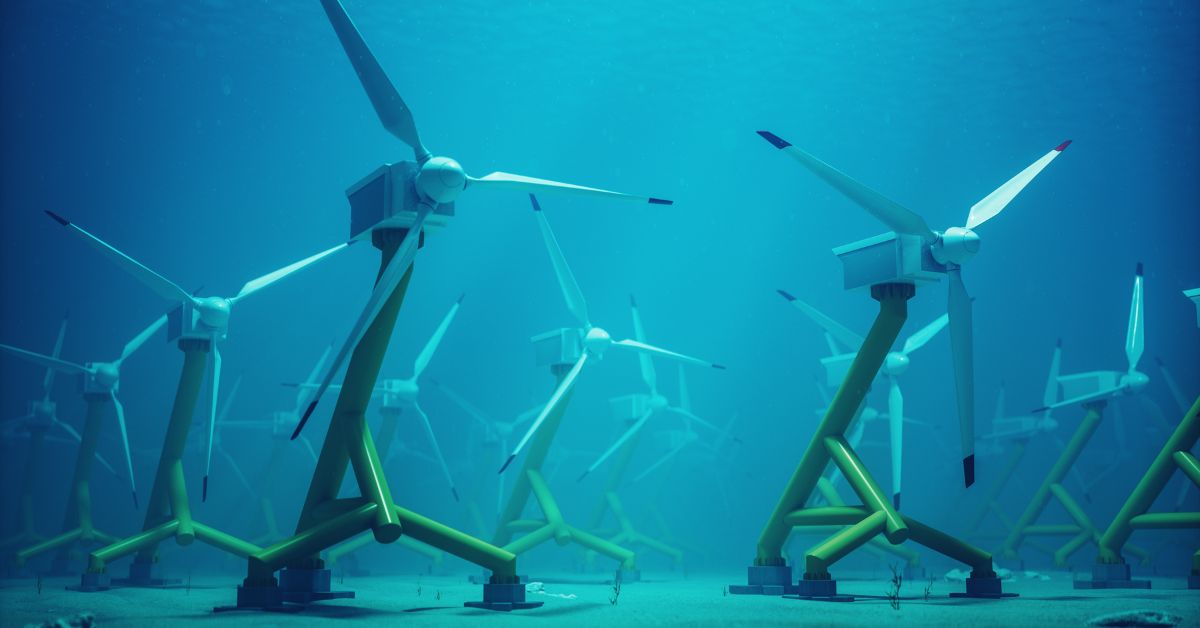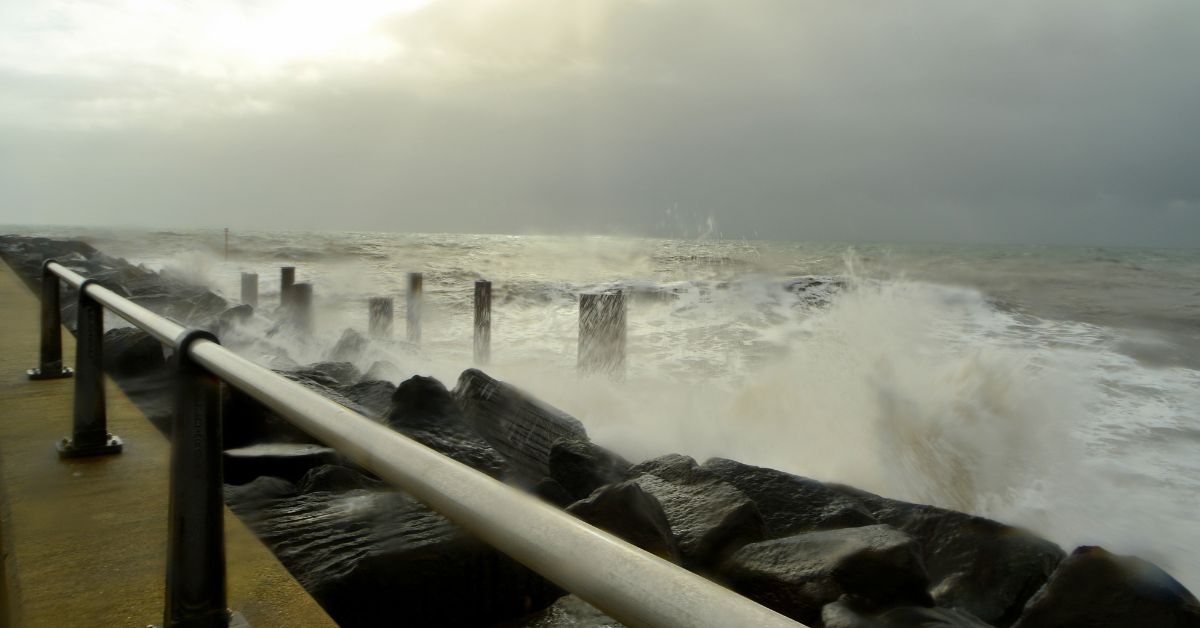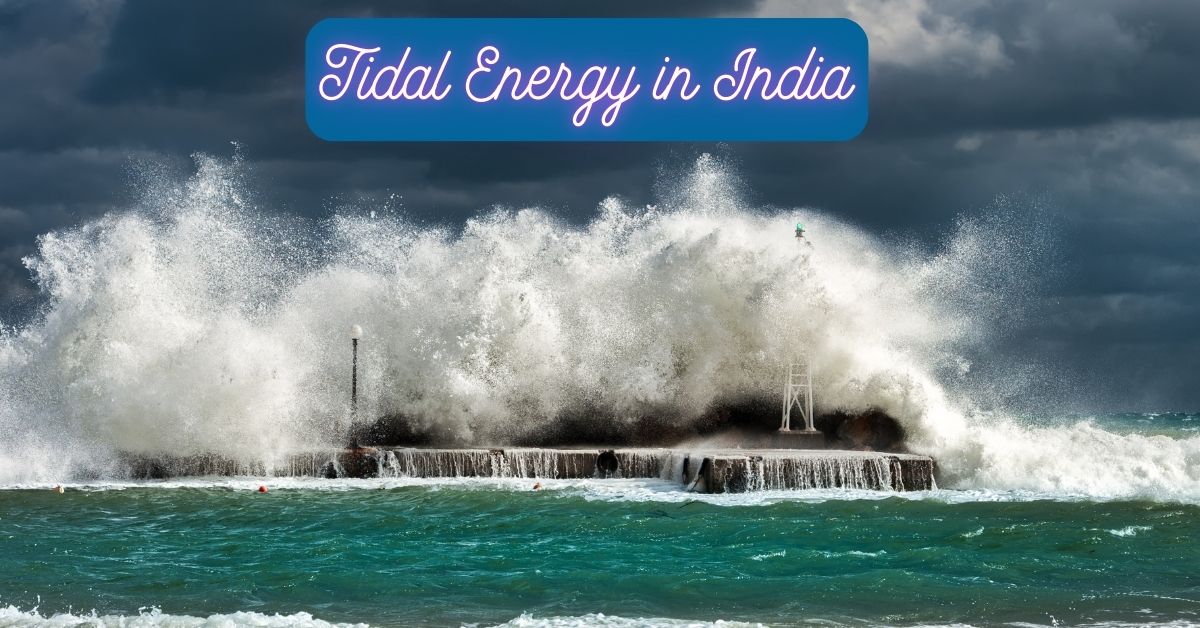Tidal Energy in India
Tidal energy in India harnesses the kinetic and potential energy of ocean tides to generate renewable electricity. With a vast coastline of over 7,500 kilometers, India is well-positioned to explore this sustainable energy source, particularly in regions like the Sundarbans and Gulf of Khambhat.
The technology involves underwater turbines or barrages that capture the ebb and flow of tides, converting water movement into power. As India seeks to diversify its energy mix and reduce carbon emissions, tidal energy presents a promising opportunity for clean power generation, fostering energy security and supporting the country’s commitment to sustainable development.
Table of Contents
Tidal Energy in India: Harnessing the Power of the Ocean
Introduction to Tidal Energy
Tidal energy is a form of renewable energy that harnesses the natural rise and fall of ocean tides to generate electricity. Tides are caused primarily by the gravitational forces exerted by the moon and the sun on Earth’s water bodies, along with Earth’s rotation. Tidal energy is a predictable and sustainable source of energy, as tides follow regular and cyclical patterns. Unlike wind or solar energy, which can be intermittent, tidal patterns are highly predictable, making tidal power a reliable and consistent renewable energy source.
India, with its vast coastline and several potential tidal energy sites, holds significant promise for tidal energy development. While tidal energy is still in its nascent stages in India compared to other renewable energy sources such as wind and solar, it offers immense potential to contribute to the country’s clean energy goals and reduce its dependence on fossil fuels.
This blog post delves into the importance, potential, and future of tidal energy in India, addressing various aspects such as technology, challenges, case studies, environmental impacts, and government initiatives.
Why Tidal Energy?
India is committed to increasing its share of renewable energy in the national energy mix to combat climate change, reduce pollution, and enhance energy security. As part of its commitments under the Paris Agreement and its goal of achieving net-zero emissions by 2070, the country has been actively exploring various renewable energy sources. While solar and wind energy have seen massive growth, tidal energy remains largely untapped, despite its significant potential.

Tidal energy has several advantages that make it an attractive option for India’s clean energy future:
- Predictability: Unlike wind or solar power, which are subject to weather conditions, tidal movements are highly predictable. This ensures a steady and reliable supply of electricity.
- Sustainability: Tidal energy is generated by natural processes, and as long as there are oceans and tides, this form of energy will remain available.
- Longevity of Infrastructure: Tidal power plants, once constructed, tend to have long lifespans, often exceeding 100 years, making them a sound long-term investment.
- Low Greenhouse Gas Emissions: Tidal energy generates power without emitting greenhouse gases, making it a clean and environmentally friendly energy source.
- Local Economic Benefits: Tidal energy projects can spur economic development in coastal regions, providing jobs and encouraging technological innovations.
Tidal Energy Technologies
The conversion of tidal energy into electricity can be achieved through several technologies. These methods differ based on the way they harness the tidal forces and convert them into usable power:
- Tidal Barrages:
Tidal barrages are large dams or barriers constructed across the entrance of an estuary or bay. As the tide rises and falls, water flows through turbines installed in the barrage, which generates electricity. This method takes advantage of the potential energy difference between high and low tides.- Advantages: Highly efficient and can produce a significant amount of electricity.
- Challenges: High construction costs, environmental concerns regarding the disruption of local ecosystems, and the need for specific geographic conditions.
- Tidal Stream Generators:
These devices work similarly to underwater wind turbines, utilizing the kinetic energy of moving water caused by tidal currents. As water flows past the blades of the turbines, it generates rotational motion that powers an electric generator.- Advantages: Less invasive compared to tidal barrages and can be installed in a wider range of locations.
- Challenges: Technology is still evolving, and the output is relatively lower compared to tidal barrages.
- Dynamic Tidal Power (DTP):
This is an innovative and experimental form of tidal power generation, involving the construction of large dams that extend perpendicular to the coastlines. These structures exploit both tidal height and flow to generate electricity.- Advantages: Can potentially generate large amounts of power.
- Challenges: It is still in the conceptual phase and has not been tested on a large scale.
- Tidal Lagoons:
Tidal lagoons are similar to tidal barrages but are built within a contained body of water, creating artificial reservoirs that harness tidal energy. These lagoons are designed to minimize ecological disruption compared to traditional barrages.- Advantages: Offers more flexibility in site selection and a smaller environmental footprint.
- Challenges: High initial construction costs and ongoing maintenance needs.
The potential of Tidal Energy in India
India’s geographic position, with a coastline spanning over 7,500 kilometers, provides significant opportunities for the development of tidal energy. The country’s potential for tidal energy can be divided into two main regions: the Gulf of Kutch and the Gulf of Khambhat, both located in Gujarat, and the Sundarbans Delta in West Bengal.

- Gulf of Kutch:
The Gulf of Kutch, located on the western coast of India, has an average tidal range of 5 to 6 meters, making it a promising site for tidal power generation. This area could support tidal stream turbines and potentially tidal barrages. - Gulf of Khambhat:
The Gulf of Khambhat, also in Gujarat, has one of the highest tidal ranges in India, reaching up to 12 meters in some locations. It is widely considered one of the best locations for tidal energy projects due to the large tidal range and strong tidal currents. - Sundarbans Delta:
Located in the eastern part of India, the Sundarbans Delta experiences tidal ranges of up to 5 meters. Though the area is ecologically sensitive, it holds potential for small-scale tidal energy projects that could benefit local communities without causing significant environmental damage.
Current Tidal Energy Projects in India
While India has yet to establish a commercial-scale tidal energy project, several pilot projects and feasibility studies have been conducted over the years. A few notable initiatives include:
- Gulf of Khambhat Tidal Energy Project:
Gujarat, with its high tidal range, has been the focal point for several tidal energy initiatives. The state government, in collaboration with private companies, explored the possibility of establishing a tidal energy project in the Gulf of Khambhat. However, high costs and technological challenges have delayed the project’s implementation. - West Bengal Tidal Energy Projects:
West Bengal’s coastal areas, particularly the Sundarbans region, have been identified as potential sites for small-scale tidal power projects. The region’s proximity to Bangladesh, where tidal energy projects are also being explored, provides an opportunity for cross-border collaboration in this sector.
Challenges Facing Tidal Energy in India
Despite its potential, tidal energy development in India faces several significant challenges that have prevented it from becoming a mainstream source of energy.
- High Initial Costs:
Tidal energy infrastructure requires significant upfront investment, especially for tidal barrages and lagoons. The construction of large-scale tidal power plants involves high costs for materials, installation, and maintenance. - Technological Barriers:
While tidal energy technology has advanced in recent years, it is still relatively underdeveloped compared to other renewable sources such as wind and solar. India lacks sufficient technological expertise in this area, and the limited number of successful tidal projects worldwide means there is still a lot to learn about optimizing this technology. - Environmental Concerns:
Building tidal barrages and lagoons can disrupt marine ecosystems, affect fish migration patterns, and alter the natural sediment flow in estuaries and coastal areas. Careful environmental assessments are necessary to mitigate these impacts. - Lack of Policy Support:
While the Indian government has shown interest in renewable energy, the focus has primarily been on wind and solar power. Tidal energy has not yet received the same level of attention in terms of policy incentives, subsidies, or research and development funding. - Geographic Constraints:
Tidal energy is location-specific and can only be harnessed in areas with significant tidal ranges. This limits the potential for tidal energy to be a nationwide solution, as only certain coastal areas are suitable for large-scale projects.
Government Initiatives and Support
Recognizing the potential of tidal energy, the Indian government has initiated efforts to explore this renewable energy source. However, compared to solar and wind energy, tidal power has not received the same level of support. Some key initiatives include:
- National Institute of Ocean Technology (NIOT):
The NIOT has been actively involved in researching ocean energy technologies, including tidal energy. The institute has conducted studies to identify potential tidal energy sites and assess the feasibility of developing tidal power plants in India. - Public-Private Partnerships:
The Indian government has encouraged public-private partnerships (PPP) for the development of renewable energy projects, including tidal energy. These collaborations aim to bring together government resources and private sector expertise to drive innovation and reduce costs. - International Collaborations:
India has also explored opportunities for international collaboration in tidal energy development. For example, partnerships with countries like the UK, which has advanced tidal energy technology, could help India accelerate the development of its tidal power sector.
Environmental Impacts of Tidal Energy
One of the key considerations for tidal energy projects is their environmental impact. While tidal energy is a clean and renewable source of power, the construction and operation of tidal power plants can have various ecological consequences. These include:
- Disruption to Marine Life:
Tidal barrages and turbines can alter the natural flow of water, potentially affecting fish migration patterns and the habitats of marine species. Efforts must be made to minimize these disruptions through careful site selection and the use of environmentally friendly technologies. - Sediment Flow Alteration:
The construction of tidal barrages or lagoons can affect the natural movement of sediment in estuaries and coastal areas, which could lead to erosion or changes in water quality. This issue can be addressed through careful design and ongoing environmental monitoring. - Noise Pollution:
The operation of tidal turbines can generate underwater noise, which may disturb marine life, particularly species that rely on sound for communication or navigation.
The Future of Tidal Energy in India
Tidal energy offers significant potential for India’s renewable energy future, particularly as the country looks to diversify its energy mix and reduce its carbon footprint. However, for tidal energy to become a viable part of India’s energy portfolio, several steps need to be taken:

- Investment in Research and Development:
India needs to invest in research and development to advance tidal energy technologies and reduce the costs associated with their implementation. This could include partnerships with countries that have already made strides in tidal energy, such as the UK or France. - Incentives for Private Investment:
The Indian government should introduce policies that incentivize private investment in tidal energy, such as subsidies, tax breaks, and guaranteed feed-in tariffs. This would help attract more companies to invest in the sector and drive innovation. - Environmental Safeguards:
Any tidal energy projects must be developed with a strong focus on environmental sustainability. This includes conducting comprehensive environmental impact assessments and adopting technologies that minimize harm to marine ecosystems. - Pilot Projects:
India could begin by developing small-scale pilot projects in promising locations such as the Gulf of Kutch and the Sundarbans. These projects would provide valuable insights into the technical, economic, and environmental challenges of tidal energy, helping to refine the technology for larger-scale implementation. - Public Awareness and Support:
Building public awareness about the benefits of tidal energy is crucial for gaining community support for projects, especially in coastal areas. Government and private stakeholders should engage with local communities, ensuring that tidal energy development provides local economic benefits and minimal ecological disruption.
FAQs About Tidal Energy in India
Q1. What is tidal energy, and how does it work?
Tidal energy is a form of renewable energy generated from the movement of tides caused by the gravitational pull of the moon and sun. It works by using tidal turbines or barrages to capture the kinetic energy from moving water, converting it into electricity.
Q2. Why is India interested in tidal energy?
India is interested in tidal energy because it has a vast coastline of over 7,500 km, which offers significant potential for generating renewable energy. Tidal energy is predictable and sustainable, helping India diversify its energy sources and reduce reliance on fossil fuels.
Q3. What are the major tidal energy projects currently in India?
Some notable tidal energy projects in India include the Gujarat Tidal Energy Project, the Danish Government’s tidal energy initiative in the Gulf of Khambhat, and the proposed Sundarbans tidal energy project in West Bengal.
Q4. What are the environmental impacts of the tidal energy?
Tidal energy is generally considered environmentally friendly, but it can disrupt local ecosystems, affect fish migration patterns, and alter sediment transport. Assessing and mitigating these impacts is essential during project planning and implementation.
Q5. How does tidal energy compare to other renewable energy sources in India?
Tidal energy offers advantages such as predictability and reliability compared to solar and wind energy, which are more variable. However, tidal energy has a higher initial investment cost and fewer suitable locations than solar and wind.
Q6. What are the challenges facing tidal energy development in India?
Challenges include high capital costs, limited technological expertise, environmental concerns, and the need for extensive research and feasibility studies to identify suitable sites for tidal energy projects.
Q7. How does tidal energy contribute to India’s energy security?
By diversifying its energy mix, tidal energy can enhance India’s energy security, reducing dependence on imported fossil fuels and providing a stable and reliable power supply, especially for coastal communities.
Q8. What role does government policy play in the growth of tidal energy in India?
Government policies, such as incentives for renewable energy projects, funding for research and development, and establishing regulatory frameworks, are crucial for promoting tidal energy development and attracting investments.
Q9. Can tidal energy help in combating climate change in India?
Yes, tidal energy can significantly reduce greenhouse gas emissions by providing a clean energy source, thus helping India meet its climate targets and transition to a more sustainable energy future.
Q10. How can individuals and communities engage with tidal energy initiatives in India?
Individuals and communities can engage by advocating for local tidal energy projects, participating in public consultations, supporting renewable energy policies, and exploring educational programs related to tidal energy and sustainability.
Tidal energy represents an untapped frontier in India’s renewable energy landscape. While the country has made impressive strides in wind and solar energy, the potential for harnessing tidal power remains largely unrealized. With its long coastline and significant tidal range in certain areas, India has the opportunity to become a leader in tidal energy technology.
However, for this to happen, India will need to overcome several challenges, including high costs, technological limitations, and environmental concerns. By investing in research and development, incentivizing private investment, and carefully planning projects with environmental safeguards, India can harness the power of its tides to create a sustainable and reliable source of renewable energy.
In the coming years, as the technology matures and costs come down, tidal energy could become an integral part of India’s renewable energy strategy, helping the country meet its ambitious climate goals while ensuring energy security for future generations.
Click here to learn more about Tidal Energy in India
Click here to learn more about Types of Solar Power Plants in India

